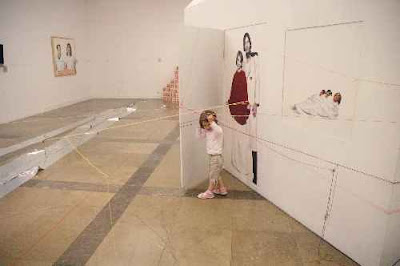The aim of this blog is to stimulate a dialogue without any borders between East and West, from a neutral point of view. At the basis of this interaction we will use art in its broadest sense, offering themes or just events that can be analysed. Feel free to give your opinion, feel free to express the relation between life and art, feel free to be yourself, because finally this is what it is all about.
vrijdag 23 januari 2009
EROTICA
According to the artist, Balkan Erotic Epic "is part of the research into Balkan popular culture and its use of eroticism. Through eroticism, humans attempt to make themselves equal with the gods. In folklore, the woman marries the sun and the man marries the moon to preserve the secret of creative energy; through eroticism, humans can get in touch with the indestructible cosmic forces."
According to Abramovic's previous investigations, human beings use eroticism in an attempt to attain equality with the gods: obscene objects and male and female genitals have a very important function in the fertility and agricultural rites of the Balkans. In her research for this work, the artist consulted ancient manuscripts and analysed medieval pagan rituals that have been part of Slavic culture since the Middle Ages.
Throughout her prestigious career, the axis of Abramovic's work has been her own body - a territory for experimentation and change, the canvas of her artistic expression. The artist conceives her actions as a space in which to release her personal ghosts, but also as a way of relating to reality. For Abramovic, the human body is "condition, opportunity and impediment all in one; an existential springboard for any kind of spiritual development."
Abramovic's main field of study throughout her artistic career has focused on the search for the physical and mental limits of the human body, and she was one of the pioneering figures of performance art in the 1970s. This interest has led her to research other non-Western cultures and to study their unique ways of exorcising fear of pain and death - feelings that are constant features of our modern-day Western society.
www.absolutearts.com
donderdag 22 januari 2009
CONFLICT
 Today, Interpol is known mostly as the project where Alexander Brener destroyed the work of art of Wenda Gu and where Oleg Kulik performed a dog. And according to his role bit the spectators at the opening and, of course, ended at the police station. Apart from this, Interpol is also famous for an open letter, a document of protest, that some participants of the project, the so-called �Western side,� wrote against the attitude of the members of the so-called Eastern side, and sent it to the world�s art community. So in the art world Interpol is probably also known as the paradigmatic East-West issue project. How boring! The paradox, however, is that when we, who created this project and participated at it, finally leaving aside what came out of it, try to reconstruct the narrative of what happened, inevitably have to conclude that our stories are different, that our memory is unreliable, that there is no simple solution to the problem. This book is a collection of essays initiated by the Interpol project.
Today, Interpol is known mostly as the project where Alexander Brener destroyed the work of art of Wenda Gu and where Oleg Kulik performed a dog. And according to his role bit the spectators at the opening and, of course, ended at the police station. Apart from this, Interpol is also famous for an open letter, a document of protest, that some participants of the project, the so-called �Western side,� wrote against the attitude of the members of the so-called Eastern side, and sent it to the world�s art community. So in the art world Interpol is probably also known as the paradigmatic East-West issue project. How boring! The paradox, however, is that when we, who created this project and participated at it, finally leaving aside what came out of it, try to reconstruct the narrative of what happened, inevitably have to conclude that our stories are different, that our memory is unreliable, that there is no simple solution to the problem. This book is a collection of essays initiated by the Interpol project.From http://www.ljudmila.org/interpol/
Read also http://xz.gif.ru/numbers/moscow-art-magazine/interpol
OLEG KULIK
ALEXANDER BRENER 1994 "Snows of Kilimanjaro". Arbat St., Moscow

See also http://www.unt.edu/honors/eaglefeather/2005_Issue/2005_PDFs/Nersesova.pdf
THERAPY

Paramedicine, Unique Colour Schemes and Irony in the Work of Grzegorz Sztwiertnia
Irony is a constant element in Grzegorz Sztwiertnia's work, but in the artist's special understanding it is a warm expression of his relationship to the world, respect for mankind, skilfully balancing between seriousness and jest. He uses irony like a friendly pat on the arm. It comes from an earlier developed or inborn gift to take some distance from reality, and above all, from himself.
The artist appeals to the viewer's intellectual imagination: he invents therapies, conducts research and constructs models which he theoretically explains and practically demonstrates. Grzegorz Sztwiertnia supplements the contemporary art's concern with the issue of the body with the issue of the soul. He opens space for the imagination, intellectual play, ambiguity. His work enjoys more and more recognition among experts, and other viewers are alternately fascinated and terrified. It is multifaceted, rich and erudite, and requires a great deal of attention to be understood and intelligently interpreted.

From http://www.krakow.pl/en/kultura/krakow_miasto_artystow/?id=001.html
Abonneren op:
Reacties (Atom)

